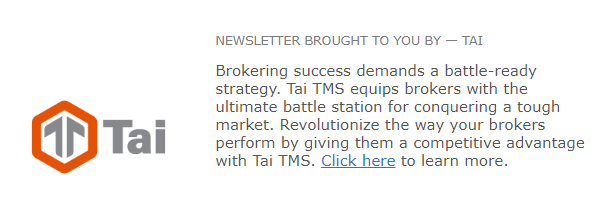Freight News:
Check Call: Hope for a ban on noncompetes heads to court
In this edition: The dream that may or may not come true under the FTC’s new rule, and TFI International wants heavier freight.

Last Tuesday, the Federal Trade Commission dropped the mother of all rules. The agency banned noncompetes. The ban was going to remove any existing noncompete and bar new ones provided that employee wasn’t a senior executive or higher. The rule was to go into effect 120 days after it was published in the Federal Register, which normally takes about three days. The full rule is 570 pages if you wanna read it in full.
The original rule proposed about nine months ago had 26,000 comments with only 1,000 of those comments in favor of noncompetes. The FTC estimates that 30 million Americans are under noncompetes across a myriad of industries. The agency stated that “Noncompetes often force workers to either stay in a job they want to leave or bear other significant harms and costs, such as being forced to switch to a lower-paying field, being forced to relocate, being forced to leave the workforce altogether, or being forced to defend against expensive litigation.”
Not even a full 24 hours later came what I can only assume is the first of many lawsuits against the FTC, by the U.S. Chamber of Commerce, an advocacy group that represents 3 million businesses. It alleges that the rule is “blatantly unlawful and noncompete agreements are an important tool in fostering innovation and preserving competition.” It said the FTC has no authority to make such sweeping rules.
The FTC’s response to the lawsuit could not be clearer: “Our legal authority is crystal clear,” FTC spokesperson Douglas Farrar told CNBC in a statement. “Addressing noncompetes that curtail Americans’ economic freedom is at the very heart of our mandate, and we look forward to winning in court.”
The popcorn is popped, and I am ready to watch the court cases unfold.
As for what it means for those in the freight space stuck in a noncompete, well it’s not as positive as it was when the rule was originally proposed. Basically nothing has changed in the land of noncompetes as of this moment. The case has to be heard, and then what happens with the first case is likely to set everything else in motion.
Personally, I would be shocked if the case didn’t end up at the Supreme Court. The last time the FTC was accused of overstepping its bounds, in Humphrey’s Executor v. United States, the Supreme Court ruled in favor of the agency.
Maybe in like two years we’ll finally have a ruling on whether the ban goes into effect as written or if it’s adjusted in any way. Right now the only hope of something changing sooner is if elected officials at either the state or federal level pass any sort of legislation banning noncompetes.
For those trapped in a noncompete and not living the dream, there is a light at the end of a very long tunnel.

Market Check. Taking a trip up north to Minneapolis, there is some loose capacity. Outbound tender volumes have fallen 5.05% week over week, for the second-lowest level in April. Rejections, on the other hand, have leveled off with very little w/w change. The stability in rejections indicates that spot rates will not see much change unless outbound tender volumes continue to fall. Then spot rates will drop as capacity would be significantly down in the market. As for carrier compliance, shippers and brokers alike should be thrilled that carriers are 97% compliant with loads tendered.

Who’s with whom? Those who have some dense LTL freight might want to hit up TFI International. After the first-quarter earnings call, the general consensus is that the company is looking for heavier freight. With LTL carriers all having a desired “freight profile,” it becomes tricky to know what each one prefers.
TFI CEO Alain Bedard said on the earnings call, “We’re educating ourselves to bring us freight that fits the model. We’ve been saying, ‘Guys, don’t bring us freight where the average weight is 1,075 pounds per shipment.’”
The company had an average weight per shipment of 1,209 pounds in the quarter, which is up from the first quarter of last year when it was 1,063. LTL rates are priced on hundredweights, meaning the heavier a shipment is, the more the carrier stands to get paid. Obviously the overweight and bulky freight isn’t as ideal as palletized, double-stackable, dense freight. Also it sounds like the billing system is in the middle of getting an overhaul, which is always appreciated.
The more you know
Over the past decade, C.H. Robinson lost its moat to innovation and competition
Borderlands Mexico: China boosts its Mexico investments as nearshoring opportunities grow
Abundant capacity is hiding freight pattern shifts
Supreme Court: Drivers hauling baked goods are in transportation, not baking
Activists looking to oust Norfolk Southern management get key support
The post Check Call: Hope for a ban on noncompetes heads to court appeared first on FreightWaves.
Source: freightwaves - Check Call: Hope for a ban on noncompetes heads to court
Editor: Mary O'Connell

